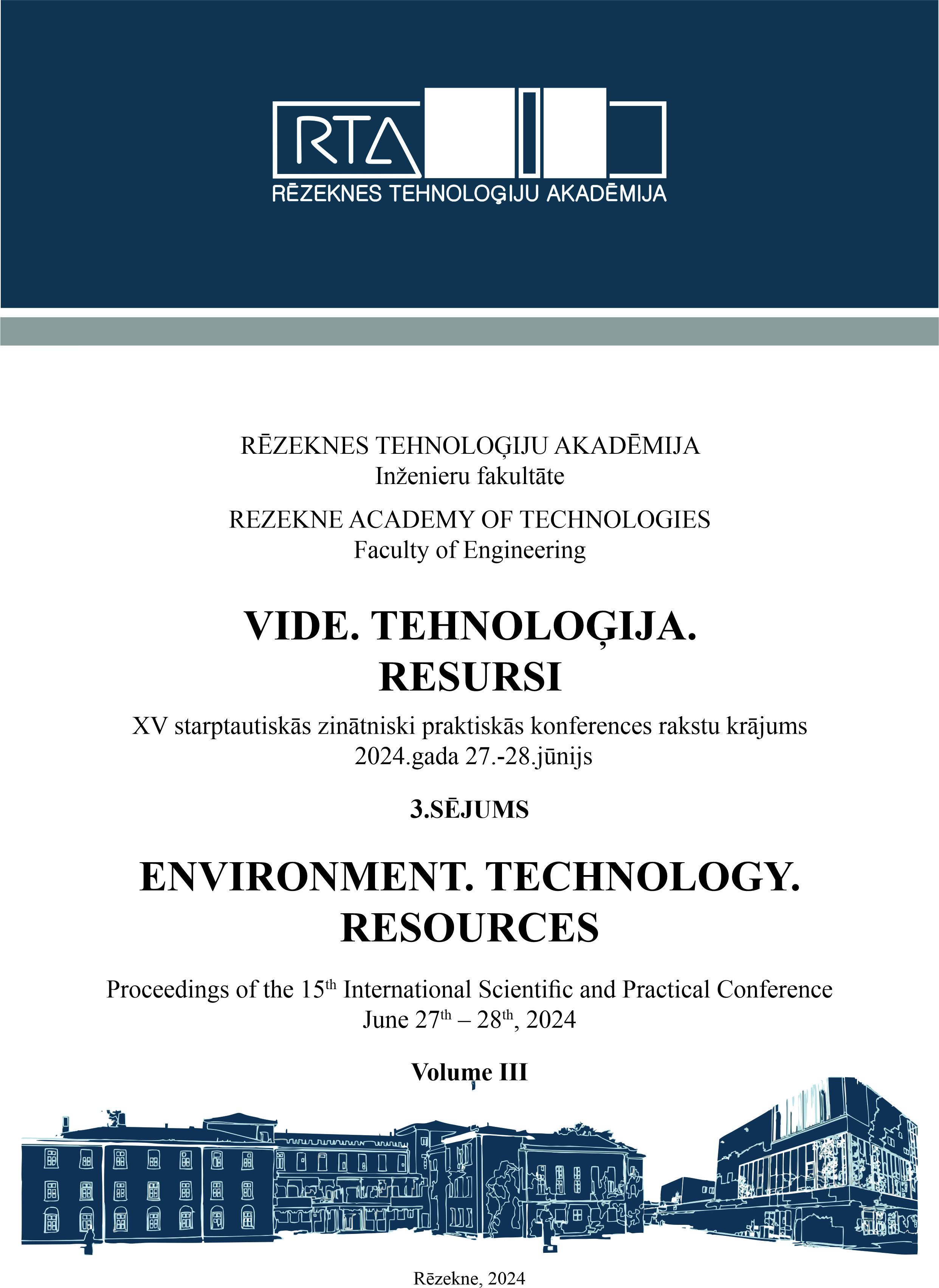INVESTIGATION OF THE OPTIMIZATION PROCESS OF LASER SURFACE MARKING ON POLYAMIDE SAMPLES
DOI:
https://doi.org/10.17770/etr2024vol3.8168Keywords:
fiber laser, laser marking, polyamide, roughness, contrastAbstract
Give Thermoplastic laser marking technology is becoming increasingly popular in the electronics industry. Using marking codes requires more information to store, which requires the marking to be of good contrast and durability over time. The main goal of the research was to achieve high-quality marking on polyamide surfaces. A nanosecond fiber laser was used to laser mark polyamide samples. An experimental marking matrix of 8 columns and 6 rows was developed, respectively varying the marking step, scanning speed, marking repeats. The dimensions of the marked squares are 10×10 mm. Surface changes and marking quality were examined using a laser scanning microscope. Markings with good contrast were found, as well as marking modes with partial and full melting modes. Roughness and contrast were measured for the optimal marking modes. Graphical dependences are constructed for the effect of roughness and contrast on propagation speed and distance in laser marking. For the study, the average laser power was fixed. During the experiment, it was found that laser marking on polyamide can lead to different shades of gray and yellow, and the surface after laser treatment has become rougher.
References
L. Lazov, H. Deneva, P. Narica, “Laser marking methods,” Environment. Technology. Resources. Proceedings of the International Scientific and Practical Conference, vol. 1, p.108-115, 2015. [Accessed January 10, 2023], http://dx.doi.org/10.17770/etr2015vol1.221
I. Balchev, L. Lazov, et al., Investigation of the influence of the scanning speed and step in laser marking and engraving of aluminum, 2021, J. Phys., Conf. Ser., 1859 012002, https://doi.org/10.1088/1742-6596/1859/1/012002
L. Lazov, N. Angelov, Influence of some technological parameters on the contrast of laser marking on the fly. Laser Phys., 2012, 22, 1755–1758 . https://doi.org/10.1134/S1054660X12110084
R. M. Boom, “Membrane Formation by Immersion Precipitation: The Role of a Polymerıc Additive, ”Proefschrift Enschede. Netherlands. ISBN 90-9005223-2, 1992.
E. Bitay, “ELaser markability of PVC coated automotive electric cables,” Express Polymer Letters, vol. 13, p. 379-389, 2019. [Accessed January 12, 2023], https://doi.org/10.3144/expresspolymlett.2019.31
I. D. Savu, S. V. Savu, N. A. Sirbu, “Heat affected zones in polymer laser marking.”J Therm Anal Calorim, vol.115, p.1427–1437, 2014. [Accessed February 25, 2023], https://doi.org/10.1007/s10973-013-3443-2
S. Y Li, X. R. Dang, Y. Zhang, “Recent progress of laser marking on plastics, ” China Plastics technology Industrialization Symposium, p366-374, 2009. [Accessed January 9, 2023].
A. Burgess, K. Feng, “Color laser marking: a new marking and decorating alternative for olefins”. Coloring Technology for Plastics, p301–307, 1999. [Accessed January 25, 2023], https://doi.org/10.1016/B978-188420778-5.50039-5
H. W. Li, “Preparation of laser markable polyamide compounds. Journal of Physics: Conference Series, 1765, 2021. [Accessed January 9, 2023], https://doi.org/10.1088/1742-6596/1765/1/012003
E. Neiss, M. Flury, J. Fontaine, “Diffractive optical elements for laser marking applications,” Optical Sensors, vol. 7003, p. 1-8, 2008. [Accessed January 9, 2023], https://doi.org/10.1117/12.779944
T. J. McKee, L. Toth, W. Sauerer, “Customized Decorating of Plastic Parts with Gray Scale and Multi-Color Images Using Lasers,” Coloring Technology for Plastics, p.295–300, 1999. [Acessed March 13, 2023], https://doi.org/10.1016/B978-188420778-5.50038-3
Z. Jia, K. Zhao, W. Liu, J. Ma, L. Wang,“Nanosecond pulsed laser processing circuits on the copper clad polyimide,” International Journal of Machining and Machinability of Materials, vol.15, p.157-173, 2014. [Accessed March 16, 2023], https://doi.org/10.1504/IJMMM.2014.060547
Z. Cao , G. Lu, H. Gao, Z. Xue, K. Luo, K. Wang, M. Luo, “Preparation and laser marking properties of poly (propylene)/molybdenum sulfide composite materials.” ACS omega, vol.6(13), p.9129-9140, 2021, [Accessed February 25, 2023], https://pubs.acs.org/doi/abs/10.1021/acsomega.1c00255
D. G. Waugh, J. Lawrence, P. Shukla, C. Chan, I. Hussain, H. C Man, G. C. Smith, “Laser surface treatment of polyamide and NiTi alloy and the effects on mesenchymal stem cell response,” Industrial Laser Applications Symposium, 2015. [Accessed January 9, 2023], https://doi.org/10.1117/12.2182432
S. R. Sabreen, "Fiber laser marking on nylon (polyamide) plastics," April 2021. [Online]. Available: https://plasticsdecorating.com/articles/2021/fiber-laser-marking-on-nylon-polyamide-plastics/ [Acessed March 13, 2023]
M. Hofmann, F. Breitenfellner, N. Buhler, R. C. Sykes, H. Gugger, “High Contrast and intact Surface - a Challenge in Laser Marking of Plastics,” Lasers in Motion for Industrial Applications, vol. 744, p. 156-180, 1987. [Acessed March 13, 2023], https://doi.org/10.1117/12.966970
T. W. Ng and S. C. Yeo, “Aesthetic laser marking assessment,” Optics & Laser Technology, vol. 32 no. 3, p. 187–191, 2000. [Accessed January 9, 2023], https://doi.org/10.1016/S0030-3992(00)00040-2
Risham Singh Ghalot, L. Lazov, et al., Investigation of the Change in Roughness and Microhardness during Laser Surface Texturing of Copper Samples by Changing the Process Parameters, 2023, Coatings, 13(11):1970, https://doi.org/10.3390/coatings13111970
L. Lazov, et al., Modification of the roughness of 304 stainless steel by laser surface texturing (LST), Laser Physics, 2023, Volume 33, Number 4, https://doi.org/10.1088/1555-6611/acbb76
N.Angelov, Investigation the Influence of the Number of Repetition and Volumetric Energy Density on Laser Marking of Products, Contemporary Materials, V−2, pp. 251-253, 2014, https://doi.org/110.7251/COMEN1402250A
Downloads
Published
Issue
Section
License
Copyright (c) 2024 Anželika Litavnieka, Imants Adijāns, Emil Yankov, Lyubomir Lazov, Artis Bikovs

This work is licensed under a Creative Commons Attribution 4.0 International License.



